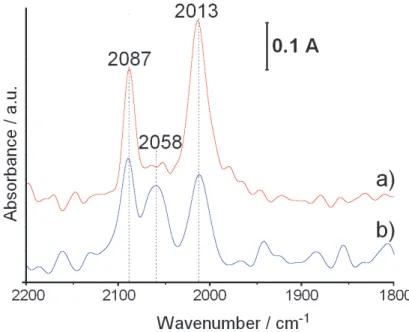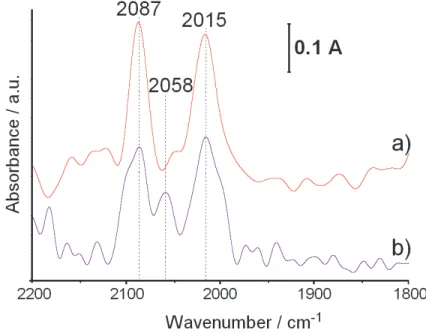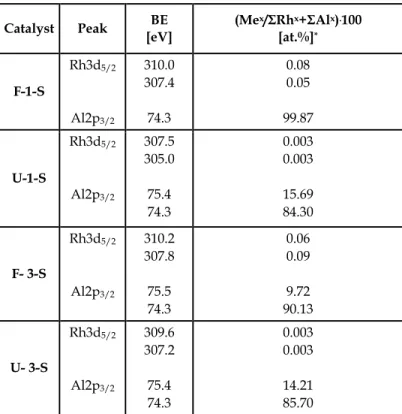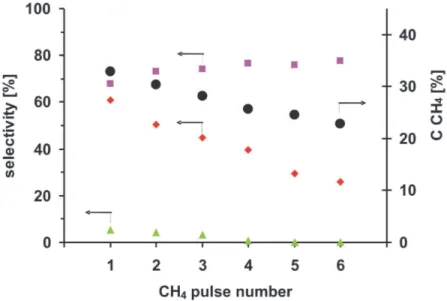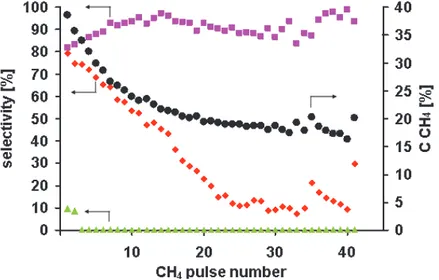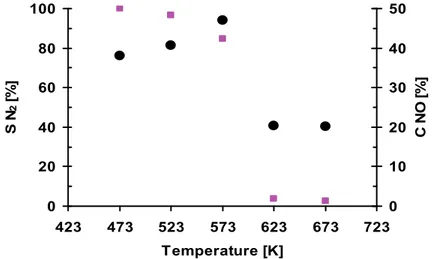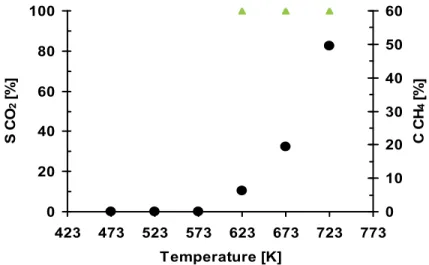Alloying Effect in Low Loaded Rh Catalysts
Supported on High Surface Area Alumina on
Their Activity in CH
4
and NO Decomposition
Mieczysława Najbar
**et al
*Faculty of Chemistry
Jagiellonian University
Poland
1. Introduction
1.1 The activity of Rh sites in Al-Rh alloys nanocrystallites in the reaction based on the electron transfer to the adsorbed molecules
In the alloys of transition metals (TM) and main group ones (MGM) the valence electrons from MGM can fill the d band of the TMs entirely and slightly increase the number of electrons in their s band (Azaroff, 1960; Kittel, 2005). Such Rh atoms enriched in electrons, present in Al-Rh alloys, were found to be very active electron donors (Pietraszek et al., 2007). It was revealed that they transfer the electrons to the antibonding Л orbital of adsorbed nitric oxide molecules causing NO decomposition to dinitrogen and dioxygen (Pietraszek et al., 2007).
Due to the great difference in the Al and Rh electro-negativity, the alloys are sometimes considered as nonstoichiometric chemical compounds. Because of the large range of nonstoichiometry those compounds should rather be estimated as intermediate phases (IP) (Azaroff, 1960).
The presence of the Al-Rh alloy nanocrystallites isostructural with Al9Rh2 (Bostrom et al.,
2005) was earlier revealed in the freshly prepared Rh/δAl2O3 catalysts containing 0.06 and
1.5 wt.% Rh (Pietraszek et al., 2007; Zimowska et al., 2006).
It is well known that in bimetallic alloy crystallites (Gasser, 1985) the metal with the lower melting point segregates in their surface layers. The melting point of aluminum is much lower than that of rhodium (Lide, 2004-2005). The enrichment in aluminum of the surface of
* Patrick Da Costa1, Jarosław Dutkiewicz2, Valerio Choque3, Narcis Homs3, Paweł Kornelak2, Agnieszka Pietraszek2, Pilar Ramirez de la Piscina3 and Janusz Sobczak4
1The Jean le Rond d’Alembert Institute, University Pierre et Marie Curie, France 2Faculty of Chemistry, Jagiellonian University, Poland
3Department of Inorganic Chemistry, University of Barcelona, Spain 4Institute of Physical Chemistry PAS, Poland
the nanocrystallites of the Al-Rh intermediate phase at temperature 873K, close to Al melting point, should be very distinct.
The electron transfer from Rh atoms enriched in electrons to the antibonding orbitals of such molecules as O2 and CH4, leading to dissociation, can also be expected. The comparison of
the enthalpy of the formation of NO, O2 and CH4 (Lide, 2004-2005) allows to expect the
following sequence of the initial temperature of the dissociation: TCH4 > TO2 > TNO.
Methane dissociation is the main step in one of the most intensively investigated process of the partial methane oxidation (PMO). Thus, it was interesting to compare the activity of the Rh active sites in the Al-Rh nanocrystallites which formed on the surface of the low-loaded Rh/Al2O3 catalysts with that of the Rh active sites in the rhodium clusters present on the
surface of the high-loaded catalysts.
The study of the influence of the concentration of the atomic oxygen surface species on the Al-Rh alloy nanocrystallites on the composition of the PMO products is necessary to understand the role of the CH4: O2 ratio in the PMO process.
The investigations of the Al segregation in the Al-Rh alloy nanocrystallites allow one to understand the evolution of the surface structure during the catalyst use at temperatures higher than the synthesis temperature.
The simultaneous studies of the NO direct decomposition and CH4 oxidation may confirm
the expected sequence of the temperatures of the initial dissociation of CH4, O2 and NO. The
knowledge of this sequence would help to estimate the temperature range of the effective direct NO decomposition in the off gases containing methane and an excess of oxygen. 1.2 The methane conversion in the oxygen presence to the synthesis gas over alumina supported rhodium catalysts
CO and H2 mixture (the synthesis gas - syn-gas) is applied in the Fischer-Tropsch and
methanol syntheses. Hydrogen for ammonia synthesis and the food industry is also obtained from the syn-gas.
At present the synthesis gas is produced mainly by the highly endothermic, and thus unfriendly for environment, methane steam reforming. The exothermic partial methane oxidation would be more economical and therefore more friendly for environment.
Since a C-H bond can be broken on Rh sites at relatively low temperatures (Wang et al., 1996), the endothermic methane dissociation to C atoms and dihydrogen, followed by carbon oxidation, is most frequently considered as a plausible mechanism of the partial methane oxidation to the synthesis gas over the Rh/Al2O3 catalysts (Enger et al., 2008;
Hofstad et al., 1998; Mallens et al., 1997; Nakagawa et al., 1999; Wang et al., 1996). At PMO temperatures hydrogen practically does not adsorb on the Rh surface and thus the possibility of its interaction with surface oxygen or OH groups is rather low ( Rieck & Bell, 1985).
The high price of rhodium limits the use of the high loaded Rh/Al2O3 catalysts. Therefore it
is of interest to investigate the possibility of the use of the low-loaded ones in PMO. In such catalysts Al-Rh alloys can be formed, besides clusters of metallic Rh, as a result of the strong metal-support interaction (SIMS) (Pietraszek et al., 2007;Zimowska et al., 2006).
As it was discussed elsewhere (Zimowska et al., 2006), calcination of the precursors of the low loaded Rh/δAl2O3 catalysts (with the specific surface area ca 287m2/g) causes Rh
incorporation into the near-to-surface layers of the alumina nanocrystallites resulting in a Rhx+/Al2O3 solid solution (Rhx+/Al2O3 s.s.) formation. The reduction of such a s.s. leads to
Al-Rh alloys.
1.3 The NO direct decomposition in the oxygen presence over alumina supported precious metal catalysts
Nitrogen oxides NOx in the flue gases from fuel combustion contain more then 90% of NO.
It is formed from air in the endothermic N2 oxidation at temperatures above 1273K. NO is a
thermodynamically unstable molecule with a high, positive formation enthalpy ∆Hºf (298) =
90,2 kJ/mol. Therefore it could decompose to N2 and O2 at low temperatures (between 293
and 973K ) (Chuang & Tan, 1997; Garin, 2001; Tonetto et al., 2003).
The NO decomposition seems to be the best way of NO removal from the flue gases of stationary sources of emission from a practical, environmental as well as an economical point of view. This process does not require any reducer that allows the avoidance of secondary pollutants like oxygenated hydrocarbons, CO, CO2, NH3 or even cyanate and
isocyanate (Chuang & Tan, 1997; Parvulescu et al., 1998; Tonetto et al., 2003). However, in the case of the direct NO decomposition N2O can be formed aside from N2 in one of the two
possible paths of the process (Parvulescu et al., 1998):
2NO → N2 + O2 (1)
2NO → N2O + ½ O2 (2)
Oxide supported Pt, Rh and Pd high-loaded catalysts are known to be the most active in the direct NO decomposition among the metal catalysts supported on metal oxides (Almusaiteer et al., 2000; Garin, 2001; Gorte et al., 1981; Ishii et al., 2002; Papp & Sabde, 2005; Pietraszek et al., 2007; Rahkamaa & Salmi, 1999; Root et al., 1983; Sugisawa et al., 2001; X. Wang et al., 2004). However, the NO dissociation proceeds on Rh active species in rhodium clusters with a satisfactory rate only above 623K and it is greatly suppressed by the oxygen presence. The reactive atomic species at such temperatures favor NO oxidation. On the other hand, the direct NO decomposition on the Rh active sites in Al-Rh alloy nanocrystallites (Pietraszek et al., 2007) formed on the low loaded alumina supported catalysts may proceed with a relatively high rate at 473K, below the temperature of the oxygen dissociation. The investigation of the alloying effect on the NO direct decomposition in the presence of oxygen and methane on a 0.18 wt.% Rh/δAl2O3 catalyst with rhodium present mostly in the
Al-Rh nanocrystallites should give relevant information about the direct NO decomposition in off gasses formed during methane combustion.
2. Results and discussion
2.1 ExperimentalTwo 0.18 wt.% Rh/δAl2O3 catalysts were obtained by one- or three-step Rh3+ deposition on
δ-alumina support. It was expected that such a procedure would produce catalysts with Rh sites of different coordination.
The structure of the Rh sites was determined by the FTIR spectroscopy of CO adsorbed and by XPS.
The δAl2O3 support (287m2/g) was obtained by the sol-gel method from aluminum
tri-sec-butylate (Zimowska et al., 2006).
The one-step (1-S) and three-step (3-S) Rh depositions were performed from a RhCl3.2H2O
aqueous solution of the same concentration.
The details of the Rh deposition as well as those of oxidising and reducing thermal treatments were described elsewhere (Pietraszek et al., 2007; Zimowska et al. 2006).
The first step of the 3-S synthesis of the 0.18 wt.% Rh/δAl2O3 catalyst consists of:
i/ the impregnation of the δAl2O3 support with the RhCl3.2H2O aqueous solution, ii/ the
drying of a wet precursor, iii/ the calcination of a dry precursor at 773K and reduction at 623K and 773K of a calcined precursor. The used procedure yields the 0.06 wt.% Rh/δAl2O3 catalyst.
The next step of the 3-S synthesis of the 0.18wt.% Rh/δAl2O3 catalyst differs from the
previous one only in the first stage; the 0.06 wt.% Rh/δAl2O3 catalyst (not the δAl2O3
support) is impregnated by the RhCl3.2H2O aqueous solution. As a result of the next drying,
calcination and reduction the 0.12wt.%Rh/δAl2O3 catalyst is obtained.
In the third step of the 3-S synthesis the 0.12 wt.% Rh/δAl2O3 catalyst is impregnated by the
same RhCl3.2H2O aqueous solution. The next drying, calcinations and reduction yields the
0.18 wt. % Rh/ δAl2O3 catalyst.
The 1-S synthesis of the 0.18 wt.% Rh/δAl2O3 catalyst consists of: i/ the impregnation of the
δAl2O3 support with a triple portion of the RhCl3.2H2O aqueous solution, ii/ the drying of a
wet precursor, iii/ the calcination of a dry precursor and the reduction of a calcined precursor.
The FTIR spectroscopy of CO adsorbed and XPS measurements were performed for the fresh one-step ( F-1-S) and step (F-3-S) catalysts as well as for the one-step and three-step catalysts subjected to the interaction with six methane pulses (U-1-S) and (U-3-S). CO was adsorbed on the surface of the catalysts at room temperature and the spectra were taken also at room temperature after outgasing at 373K using a Nicolet 5700 Nexus spectrometer at a resolution of 4 cm-1.
The XPS measurements for F-1-S, F-3-S, U-1-S, and U-3-S catalysts were carried out using a scanning photoelectron spectrometer PHI 5000 VersaProbe (Physical Electronics USA/ULVAC Japan) with monochromatic Al Kα radiation (1486.6eV). The signal was collected from 200 x200μm area using an x-ray beam focused to 100μm diameter with 25 W power. For the charge shift compensation all the measurements were made with neutralization by low energy electrons and argon ions. The survey spectra were obtained with a pass energy of 117.4eV in 0.4eV increments. The detailed spectra of the Rh3d, and the Al2p regions were measured with a pass energy of 23.5eV in 0.1eV increments. The binding energy scale (BE) was calibrated based on the Al2p in a Al2O3 support signal (BE = 74.3eV). Signal components were fitted
using a non-linear least squares fitting Casa XPS software. The quantitative analysis was done after a Shirley-type background subtraction using the Scofield sensitivity factors.
The investigation of the interaction of the catalysts with methane pulses was carried out at 873K in an acid-resistant steel tubular reactor with a 6mm internal diameter and 30cm length, under the pressure of 280 kPa and at GHSV =9000h-1. The 700 mm3 methane pulses
were introduced into the Ar stream flowing through the reactor, the Carboxen 1000 packed column and the TCD detector of a Hewlett-Packard 5890 chromatograph. The time between consecutive methane pulses was ca. 32min.
The direct NO decomposition in methane and the oxygen presence was investigated under the steady-state conditions in 473-673K temperature range. The reaction mixture of 150ppm NO 1500ppm CH4, 7%O2 andArasa balancepassed over the catalyst placed on quartz-wool
in a quartz reactor with GHSV = 20 000h-1. Before the steady-state experiment the catalyst
was heated in the reaction mixture from the r.t. to 773K and consecutive measurements were performed stepwise starting from 673K to 473K. A FID detector was used to follow the total concentration of hydrocarbons and the N2 formation was checked by a micro-GC.
2.2 The physicochemical characterisation of 0.18wt.%Rh/Al2O3 catalysts by FTIR
spectroscopy of CO adsorbed and XPS
Fig. 1. presents the FTIR spectra of CO adsorbed on the F-3-S 0.18wt.%Rh/Al2O3 catalyst (a)
and on the F-3-S 0.18 wt.% Rh/Al2O3 one (b). In agreement with the data extensively
reported in the literature (Finocchio et al., 2007 ; Hadjiivanov &Vayssilov, 2002; Kraus et al., 1989; Lavalley et al., 1990; Paul et al., 1999; Yates et al., 1979) two main bands at 2087 and 2013 cm-1, present in the spectra of both the catalysts, can be assigned to symmetric and
asymmetric stretching vibrations of gem-bicarbonyls adsorbed on the Rh atomically dispersed
Fig. 1. DRIFT spectra CO adsorbed on the surface of the 0.18 wt.% Rh /δAl2O3 catalysts
on the alumina surface. However, the exact position of the atomically dispersed Rh in the structure of catalyst has yet to be determined (Finocchio et al., 2007 ; Hadjiivanov &Vayssilov, 2002; Kraus et al., 1989; Lavalley et al., 1990; Paul et al., 1999; Yates et al., 1979). According to above cited papers the peak at 2058cm-1, clearly seen in the spectrum of the F-1-S catalyst,
results from C-O stretching vibrations in CO linearly adsorbed on the Rh clusters.
Fig. 2. DRIFT spectra of CO adsorbed on the surface of the 0.18 wt.% Rh /δAl2O3 catalysts:
a/ obtained by a three-step rhodium deposition and subjected to interaction with six methane pulses, b/ obtained by a one-step rhodium deposition and subjected to interaction with six methane pulses.
Thus one may conclude that on the surface of the F-1-S catalysts the atomically dispersed Rh coexists with the Rh clusters. However, on the surface of the F-3-S catalyst atomically dispersed species are hardly seen.
Fig. 2 presents the FTIR spectra of CO adsorbed on the three-step (a) and one-step (b) 0.18wt.% Rh/Al2O3 catalysts subjected to interaction with 6 methane pulses at 873K.
The distinct decrease of the ratio of Rh in clusters to Rh in alloy nanocrystallites as a result of the catalysts interaction with methane pulses is observed. The increase of the width of the gem-bicarbonyl peaks reveals that during the pulse experiment atomically dispersed Rh with a coordination slightly different than in the fresh catalysts is formed.
The comparison of XPS results for the fresh and used catalysts gives further insight in the nature of atomically dispersed rhodium species and in the mechanism of their creation as well as their interaction with the clustered metallic rhodium species.
In Table 1 the BEs of peaks obtained by the deconvolution oftheAl2p3/2 andRh3d5/2 bands
as well as the percentage of the particular Al and Rh species ((Mex/ΣRhx+ΣAlx).100) in F-1-S,
Catalyst Peak BE [eV] (Mex/ΣRhx+ΣAlx).100 [at.%]* F-1-S Rh3d5/2 Al2p3/2 310.0 307.4 74.3 0.08 0.05 99.87 U-1-S Rh3d5/2 Al2p3/2 307.5 305.0 75.4 74.3 0.003 0.003 15.69 84.30 F- 3-S Rh3d5/2 Al2p3/2 310.2 307.8 75.5 74.3 0.06 0.09 9.72 90.13 U- 3-S Rh3d5/2 Al2p3/2 309.6 307.2 75.4 74.3 0.003 0.003 14.21 85.70
Mx – metallic or cationic Rh and/or Al species
Table 1. The XPS results for the fresh one-step (F-1-S) and the three-step (F-3-S) 0.18 wt.% Rh/ δ Al2O3 catalysts and for those catalysts subjected to the interaction with six methane
pulses (U-1-S and U-3-S).
The Al2p3/2 bands in the spectra of the particular catalysts were deconvoluted into two
peaks. The major peaks were ascribed to Al in alumina - BE=74.3eV (Wagner et al., 2007). The BE of the less intensive Al2p3/2 peaks as well as those of the Rh 3d5/2 peaks were
determined with respect to this one. The less intensive Al2p3/2 peaks with exceptionally high
BE (75.4-75.5eV) were ascribed to Al in the Al-Rh alloy. The transfer of the valence Al electrons mainly to Rh unoccupied d-orbitals (Azaroff, 1960; Kittel, 2005) in the alloy should cause the increase of the Al2p3/2 BE and decrease of Rh3d5/2 one with respect to those in
separate metals (Wagner, 2007).
The Rh3d5/2 bands in the XPS spectra of the F-1-S and F-3-S catalysts were deconvoluted into
the peaks of cationic species with BE equal to 310.0 and 310.2eV and of Al-Rh alloy ones with BE equal to 307.4 and 307.8 eV, a little lower than that of metallic Rh (Wagner, 2007). The atomically dispersed Rh species (Finocchio et al., 2007; Hadjiivanov &Vayssilov, 2002; Kraus et al., 1989; Lavalley et al., 1990; Paul et al., 1999; Yates et al., 1979) demonstraded in the FTIR spectra of CO adsorbed on the F-1-S and the F-3-S catalysts (Fig.1) by bands at 2087 and 2013 cm-1, occur probably in the surface lattice position of the Al-Rh alloy nanocrystallites.
The presence of only one 3d5/2 peak of the Rh species with BE =307.4 eV in the spectrum of
the F-1-S catalyst reveals an electronic interaction between the Al-Rh intermediate phase nanocrystallites and the Rh clusters. It shows that the Rh clusters occur in the immediate proximity of the Al-Rh nanocrystallites. Such an electronic interaction was earlier observed by Thiam et al. (Thiam et al., 2004) between aluminum foil and a rhodium overlayer. A higher percentage of the metallic Rh species in the F-3-S catalyst (60 %) than in the F-1-S one (ca 40%) could easily be explained by the differences in the syntheses. The one-step Rh deposition is thought to have occurred preferably on the smallest nanocrystallites with the highest surface/bulk ratio, possibly by an Rh3+ cation exchange with protons of the
accessible acidic OH groups on alumina. Thus, the Rh deposition calculated per volume unit of alumina crystallites is higher the smaller their dimensions are. Rhodium clusters are formed from an excess of the aqueous Rh3+ ions solution present in pores.
On the other hand, the three-step Rh deposition occurs mostly by exchange of the Rh cations with the acidic OH group protons on the surface of the smallest δ alumina crystallites, which is renovated in each synthesis step in the course of the calcinations. It results in the exceptional enrichment of these crystallites in Rh. An incorporation of rhodium into δ alumina during the thermal treatments causes the formation of the Rhx+/Al2O3 solid
solution. The reduction of the s.s. nanocrystallites, resulting in inter-metallic Al-Rh alloy formation, is easier the higher the rhodium concentration is.
It is obvious that the enrichment of Rh atoms in electrons is the greater the higher their dispersion is in the aluminium matrix. Earlier this problem in particular was discussed regarding the Cu-Ni alloys (Kittel, 2005).
The interaction of the F-1-S catalyst with six CH4 pulses causes a complete disappearance of
the cationic Rh species and a great decrease in the content of the metallic Rh species. Simultaneously the Rh species with 3d5/2 BE equal to 305.0 eV and the Al species with an
exceptionally high 2p3/2 BE (75.4eV) do appear.
The disappearance of the cationic species reveals the formation of the new nanocystallites of the Al-Rh alloy by the reduction of the Rhx+/Al2O3 s.s. of low Rh content.
The major decrease of the content of Rh species with 3d5/2 BE close to 307 eV and the
appearance of the species with 3d5/2 BE = 305 eV and the Al ones with 2p3/2 BE = 75.4 eV
could be the result of the Al surface segregation in the alloy nanocrystallites formed at 773K. However, Rh species with 3d5/2 BE = 305 eV and the Al ones with 2p3/2 BE = 75.4 eV could
also be formed as a result of the reduction of the Rhx+/Al2O3 s.s. with a low Rh content.
The heating of the F-3-S catalyst and its interaction with 6 methane pulses causes a great decrease in the total contents of the Rh species in the surface nanolayers, the disappearance of the species with 3d5/2 BE = 307.8 eV, the appearance of the ones with 3d5/2 BE = 307.2 eV
and an increase of the content Al species with 2p3/2 BE = 75.4 eV.
The major decrease in the content of the cationic and metallic Rh species, the the decrease in the 3d5/2 BE of the Rh metallic species as well as the increase of the content of the Al
ones with 2p3/2 BE = 75.4 eV reveal the reduction of the Rh/Al2O3 s.s. areas with a small
Rh content and Al segregation in the Al-Rh alloy nanocrystallites formed at 773K. The great extent of the surface Al segregation can be caused by great difference in Al and Rh melting points and the proximity of the used temperature and the temperature of Al melting (Lide, 2004-2005).
2.3 Methane dissociation on 1-S and 3-S 0.18 wt.% Rh/δAl2O3 catalysts
In Fig 3. the methane conversion (CCH4), selectivity to hydrogen (SH2), selectivity to CO
(SCO) and selectivity to CO2 (SCO2) in six consecutive CH4 pulses over F-1-S catalyst are
presented.
Fig. 3. CH4 conversion (●) and selectivity to H2(■), CO (♦) and CO2 (▲) in six consecutive
CH4 pulses over the one-step 0.18 wt.% Rh/δAl2O3 catalyst (873K, 280kPa, 9000 h-1).
The CH4 conversion in the first pulse over the 1-S catalyst is equal to 33%, the selectivity
to H2 – 68%, the selectivity to CO - 61% and to CO2 – 10%. In the following methane pulses
CCH4 continuously decreases down to 23% in the sixth pulse. The SH2 increases up to 78 %
in the sixth pulse, SCO decreases, almost linearly, down to 22% in the sixth pulse and the
SCO2 drops to 0% in the fourth pulse.
The simultaneous decrease of the CCH4, the SCO and the SCO2 and the increase of SH2 in the
consecutive methane pulses can be explain by the decreasing concentration of the atomic species of oxygen adsorbed on the surface Rh species in Al-Rh alloy nanocrystallites and in Rh clusters present on the surface of the 1-S catalyst.
The initial SH2 increase accompanied by a decrease in SCO2 reveals that further formation of
alloy nanocrystallites with a low concentration of Rh sites have a greater ability to transfer electrons to methane molecules. The 2.8 fold decrease in the SCO in the sixth methane pulse
with respect to that in the first methane pulse with a simultaneous increase of the selectivity to hydrogen, suggesting deeper methane dissociation, clearly shows a carbon deposition on the catalyst surface as a result of the deficit of oxygen species adsorbed.
In Fig. 4 the methane conversion, selectivity to hydrogen, selectivity to CO and the selectivity to CO2 in six consecutive CH4 pulses introduced to the reactor containing the
Fig. 4. CH4 conversion (●) and selectivity to H2(■), CO (♦) and CO2 (▲) in six consecutive
CH4 pulses over the 3-S 0.18wt.% Rh/δAl2O3 catalyst (873K, 280kPa, 9000 h-1).
The CCH4 in the first methane pulse is equal to 42%, the SH2 - 83%, the SCO - 72% and the SCO2
– 11%. In the next methane pulses the CCH4 decreases down to 22% in the sixth pulse. The
SH2 increases up to 98% in the third pulse and slowly decreases to 94% in the sixth pulse. The
SCO decreases almost linearly down to 22% in the sixth pulse and SCO2 drops to 0% in the
fourth pulse.
The simultaneous decrease in the SCO2 and increase of the SH2 in the consecutive methane
pulses up to the forth one could be ascribed to the formation of the new Al-Rh alloy nanocrystallites of a low content of Rh sites with a great ability to transfer the electrons to the methane molecules adsorbed.
There is a 50% decrease in the CCH4 and approximately a 70% decrease in the SCO in the sixth
pulse in comparison with the first one, not accompanied by the decrease in the SH2 which
reveals carbon deposition on the Al-Rh alloy nanocrystallites.
The formation of the new alloy nanocrystallites by the reduction of the Rh/Al2O3 s.s. of the
relatively low rhodium concentration causes the creation of a very active Rhspecies.
The stronger SCO decrease on the 3-S catalyst (3.3 fold) of a higher activity than on the 1-S one
(2.8 fold) of lower activity reveals that carbon is preferably deposited on the Al-Rh nanocrystallites.
The higher conversion of the first methane pulse over the F-3-S catalyst than over the F-1-S reveals that the Rh active species in the Al-Rh alloy nanocrystallites are more active in the methane dissociation than those in the Rh clusters (Figs.1 and 2). The decrease of the activity of both the catalysts in the consecutive pulses corresponds to the decrease of the total content of the Rh species accessible for methane adsorption.
The slower the decrease of the methane conversion over the 1-S catalyst than that over the 3-S one may be assigned to a slower carbon deposition on the Rh clusters than on the Al-Rh nanocrystallites.
On the other hand, the higher selectivity to hydrogen over the 3-S catalyst than over the 1-S one clearly shows a beneficial influence of the Al proximity on the Rh sites ability to transfer electrons to antibonding orbitals of methane.
Fig. 5 presents CH4 conversion and selectivity to H2, CO and CO2 in 41 consecutive CH4
pulses over the 3-S 0.18wt.% Rh/δAl2O3 catalyst (873K, 280kPa, 9000 h-1). The methane
pulses were introduced into the reactor mostly in time intervals close to 30min. Less regular time intervals (30-37min.) were applied between the 11th and 17th pulses as well as the 25th
and 33rd. The CCH4 and SCO decrease and SH2 increases in consecutive pulses up to the pulse
11. Irregular intervals between the 11 - 17 pulses and the 25 – 33 ones cause fluctuations in the CCH4, the SCO and the SH2 that can be ascribed to the changes in the amount of the carbon
deposit oxidized by the oxygen from the gas phase. The 75 min. time interval between 34th
and 35th pulses resulted in the CCH4 increase of 11% and of the SCO of 110%. The increase of
the time between the 40 and 41 pulses to 110 min. results in the increase of the CCH4 of 25%
and of the SCO of 230%. However, the selectivity to hydrogen does not change distinctly in
any case. Thus, one can conclude that a long term interaction of the surface of the Al-Rh nanocrystallites, containing the carbon deposit, with the gas phase containing traces of oxygen causes both a carbon deposit removal by oxidation and oxygen adsorption. The oxidation of the carbon deposit causes the recovery of the Rh sites active in the methane dissociation that results in the increase of the CCH4. The surface oxygen species cause
oxidation of the carbon formed due to methane dissociation, that leads to the SCO increase.
However, their population is not high enough to have an effect on the SH2. Thus, to perform
the PMO with the high methane conversion and the high selectivity to CO and H2 the
proper CH4:O2 ratio is needed.
Fig. 5. CH4 conversion (●) and selectivity to H2(■), CO (♦) and CO2 (▲) in 41 consecutive
2.4 Direct NO decomposition over the three-step (3-S) 0.18 wt.% Rh/δAl2O3 catalyst
NO conversion (CNO), selectivity to N2 (SN2 ) calculatedfrom the results of the steady-state
experiments over the 3-S 0.18wt.%Rh/Al2O3 catalysts, are presented in Figure 6.
The steady-state experiment was performed with the use of the reaction gas containing 150ppm NO, 1500ppm CH4, 7%O2 and Ar as a balance.
0 20 40 60 80 100 423 473 523 573 623 673 723 Temperature [K] S N 2 [% ] 0 10 20 30 40 50 C N O [% ]
Fig. 6. NO conversion (●) and selectivity to NO (■) over three-step a 0.18 wt.% Rh/δAl2O3
catalyst (150ppmNO +1500ppm CH4 + 7%O2 /He , 20000h-1, data from steady-state
experiment)
The highest NO conversion, increasing with a temperature increase, from 38 to 47%, is observed at a temperature range 473K - 573K. The highest but decreasing from 100% to 85% selectivity to N2 is achieved in the same temperature. A simultaneous sudden drop of the
SN2 and a deep decrease in CNO are observed at 623K.
The direct NO decomposition over the high-loaded rhodium catalysts supported on alumina was earlier observed only at temperatures higher than 623K (Garin, 2001).
Thus, the low-temperature NO decomposition on the low loaded 0.18wt.%Rh/δAl2O3
catalyst confirms exceptional activity of the Rh sites in Al-Rh alloy.
A simultaneous increase of the CNO and the decrease of the SN2 with the temperature
increase in the 473K - 573K range could be explained by the competitive dissociative O2
adsorption on the Rh active sites, increasing with temperature. The atomic oxygen species block the Rh sites active in the direct NO decomposition and facilitate the NO oxidation. The simultaneous sudden drop of the SN2 and a great decrease in the CNO at 623K shows
that blocking the Rh sites-active in the NO dissociation becomes much stronger. Such blocking may originate in a methane dissociation on the same sites. In Fig. 7, the CH4
conversion (CCH4) and selectivity to CO2 (SCO2), measured during the thermo-programmed
catalyst heating at the rate of 3K/min in the reaction mixture containing 150ppm NO, 1500ppm CH4, 7%O2 and Ar as a balance, are presented.
The temperature of the sudden drop of the SN2 and CNO (Fig. 6) corresponds to the initial
temperature of the total methane oxidation to CO2 (Fig. 7). This confirms competitive
methane adsorption on the Rh active sites leading to the formation of the carbon species undergoing oxidation to CO2. 0 20 40 60 80 100 423 473 523 573 623 673 723 773 Temperature [K] S C O 2 [% ] 0 10 20 30 40 50 60 C C H4 [% ]
Fig. 7. CH4 conversion (●) and selectivity to CO2 (▲) over three-step 0.18 wt.% Rh/δAl2O3
catalyst (150ppmNO +1500ppm CH4 + 7%O2 /He , 20000h-1, data from TPSRexperiment)
3. Conclusions
The DRIFT spectroscopy of the adsorbed CO and XPS were used to show the formation of the Al-Rh alloy nanocrystallites on the surface of the 0.18 wt % Rh/δAl2O3 catalysts
obtained by the one-step or three-step impregnation of the high surface area alumina support with the RhCl3 aqueous solution (1-S and 3-S catalysts).
The effect of Al-Rh alloying on the catalyst activity in the methane dissociation and the direct NO decomposition was investigated.
The activity and selectivity to dihydrogen and to carbon monooxide of both the catalysts were determined at 873K. The results showed unambiguously that alloying distinctly enhances the Rh site activity in the electron donation to antibonding orbitals of methane molecules adsorbed. The observed enhancement of the Rh site activity was ascribed to the Al valence electrons transfer to the Rh 4d shell and slightly to the Rh 5s shell. The direct NO decomposition in the presence of oxygen and methane was investigated in the temperature range of 673-473K over a 3-S catalyst. The NO conversion with 100% selectivity to dinitrogen on the Rh active sites was revealed at an unexpectedly low temperature (473K). Simultaneous increase of the activity and decrease in the selectivity to dinitrogen with a temperature increase up to 573K clearly revealed a competitive dissociative oxygen adsorption on the same active sites. However, the sudden decrease at 623K of the catalyst activity in the NO decomposition and the selectivity to dinitrogen, accompanied by an initial methane oxidation to CO2, undoubtedly showed competitive methane dissociation.
4. Acknowledgment
The polish authors (M. N, J. D. and P. K.) acknowledge the financial support by the European Regional Development Fund under the Innovate Economy Operational Programme 2007-2013, POIG.01.01.02-12-112/09 project.
5. References
Almusaiteer, K.; Krishnamurthy, R. & Chuang, S.S.C. (2000). In situ infrared study of catalytic decomposition of NO on carbon-supported Rh and Pd catalysts. Catalysis
Today, Vol.55, No.3, pp. 291-299, ISSN 0920-5861
Azaroff, L.V. (1960). Introduction to Solids, McGRAW-Hill Book Cmpany, New York
Bostrom, M.; Rosner, H.; Prots, Y.; Burkhardt, U. & Grin,Y. (2005). The Co2Al9 Structure
Type Revisited. Zeitschrift für anorganische und allgemeine Chemie,Vol.631, No.2-3, pp.534-541, ISSN 1521-3749
Chuang, S.S.C. & Tan, C.–D. (1997). Promotion of oxygen desorption to enhance direct NO decomposition over Tb−Pt/Al2O3 catalyst. The Journal of Physical Chemistry B,
Vol.101, No.15, pp. 3000-3004, ISSN 1520-5207
Enger, B.C.; Lodeng, R. & Holmen, A. (2008). A review of catalytic partial oxidation of methane to synthesis gas with emphasis on reaction mechanisms over transition metal catalysts. Applied Catalysis A: General, Vol.346, No.1-2, pp.1-27, ISSN 0926-860X
Finocchio, E.; Busca, G.; Forzatti, P.; Groppi, G. & Beretta, A. (2007). State of supported rhodium nanoparticles for methane catalytic partial oxidation (CPO): FT-IR studies.
Langmuir, Vol.23, No.20, pp. 10419–10428, ISSN 1520-5827
Garin, F. (2001). Mechanism of NOx decomposition. Applied Catalysis A: General, Vol.222,
No.1-2, pp. 183-219, ISSN 0926-860X
Gasser, R.P.H. (1985). An introduction to chemisorption and catalysis by metals, Oxford University Press, ISBN 0-19-855163-0, New York
Gorte, R.J.; Schmidt, L.D. & Gland, J. L. (1981). Binding states and decomposition of NO on single crystal planes of Pt. Surface Science, Vol.109, No.2, pp. 367-380, ISSN 0039-6028
Hadjiivanov, K.I. & Vayssilov, G.N. (2002). Characterization of oxide surfaces and zeolites by carbon monoxide as an IR probe molecule. Advances in Catalysis, Vol.47, pp. 307-511, ISBN 0-12-007844-9
Hofstad, K.H.; Hoebink, J.H.B.J.; Holmen, A. & Marin, G.B. (1998). Partial oxidation of methane to synthesis gas over rhodium catalysts. Catalysis Today, Vol.40, No. 2-3, pp. 157-170, ISSN 0920-5861
Ishii, M.; Hayashi, T. & Matsumoto, S. (2002). Adsorption, desorption and decomposition of nitrogen monoxide on Rh(1 0 0) studied by electron-stimulated desorption, Auger electron spectroscopy and temperature-programmed desorption. Applied Catalysis
A: General, Vol.225, No.1-2, pp. 207-213, ISSN 0926-860X
Kittel, Ch. (2005). Introduction to Solid State Physics John Willey & Sons. Inc, ISBN 0-471-41526-x, USA
Kraus, L.; Zaki, M.I.; Knözinger, H. & Tesche, B. (1989). Support and additive effects on the state of rhodium catalysts. Journal of Molecular Catalysis, Vol.55, No.1, pp. 55-69
Lavalley, J.C.; Saussey, J.; Lamotte, J.; Breault, R.; Hindennann, J.P. & Kiennemann, A. (1990). Infrared study of carbon monoxide hydrogenation over rhodium/ceria and rhodium/silica catalysts. The Journal of Physical Chemistry, Vol.94, No.15, pp. 5941– 5947
Lide, D.R. (2004-2005). Handbook of Chemistry and Physics, CRC Press, ISBN 0-8493-0485-7, Boca Raton
Mallens, E. P. J.; Hoebink, J.H.B.J. & Marin, G.B. (1997). The reaction mechanism of the partial oxidation of methane to synthesis gas: A transient kinetic study over rhodium and a comparison with platinum. Journal of Catalysis, Vol.167, No.1, pp. 43-56, ISSN 0021-9517
Nakagawa, K.; Ikenaga, N.; Kobayashi, T. & Suzuki, T. (1999). Transient response of catalyst bed temperature in the pulsed reaction of partial oxidation of methane to synthesis gas over supported rhodium and iridium catalysts. Journal of Catalysis, Vol.186, No.2, pp. 405-413, ISSN 0021-9517
Papp, H. & Sabde, D.P. (2005). An investigation on the mechanism of NO decomposition over Rh/SiO2 catalysts in presence of pulse injected H2. Applied Catalysis B:
Environmental, Vol.60, No.1-2, pp. 65-71, ISSN 0926-3373
Parvulescu, V.I.; Grange, P. & Delmon, B. (1998). Catalytic removal of NO. Catalysis Today, Vol.46, No.4, pp. 233-316, ISSN 0920-5861
Paul, D.K.; Marten, C.D. & Yates, J.T.Jr. (1999). Control of RhI(CO)2 formation on Rh/Al2O3
catalysts by complexation of surface −OH groups using NH3. Langmuir, Vol.15,
No.13, pp. 4508–4512, ISSN 1520-5827
Pietraszek, A.; Da Costa, P.; Marques, R.; Kornelak, P.; Hansen, T.W.; Camra, J. & Najbar, M. (2007). The effect of the Rh–Al, Pt–Al and Pt–Rh–Al surface alloys on NO conversion to N2 on alumina supported Rh, Pt and Pt–Rh catalysts. Catalysis Today,
Vol.119, No.1-4, pp. 187-193, ISSN 0920-5861
Rahkamaa, K. & Salmi, T. (1999). Investigation of the catalytic decomposition of NO and N2O on supported Rh with transient techniques. Chemical Engineering Science,
Vol.54, No.20, pp. 4343-4349, ISSN 0009-2509
Rieck, J.S. & Bell, A.T. (1985). Studies of the interactions of H2 and CO with silica- and
lanthana-supported palladium. Journal of Catalysis, Vol.96, No.1, pp. 88-105, ISSN 0021-9517
Root, T.W.; Schmidt, L.D. & Fisher, G.B. (1983). Adsorption and reaction of nitric oxide and oxygen on Rh(111). Surface Science, Vol.134, No.1, pp. 30-45, ISSN 0039-6028
Sugisawa, T.; Shiraishi, J.; Machihara, D.; Irokawa, K.; Miki, H.; Kodama, C.; Kuriyama, T.; Kubo, T. & Nozoye, H. (2001). Adsorption and decomposition of NO on Pt (112).
Applied Surface Science, Vol.169-170, pp. 292-295, ISSN 0169-4332
Thiam, M.M.; Hrčiř , T.; Matolin, V. & Nehasil, V. (2004). EELS and AES investigation of Rh thin film growth on polycrystalline Al substrate. Vacuum, Vol.74, No.2, pp. 141-145, ISSN 0042-207X
Tonetto, G.M.; Ferreira, M.L. & Damiani, D.E. (2003). A combined theoretical and experimental study of NO decomposition on Pd and Pd-Mo catalysts. Journal of
Molecular Catalysis A: Chemical, Vol.193, No.1-2, pp. 121-137, ISSN 1381-1169
Wagner, Ch.D.; Naumkin, A.V.; Kraut-Vass, A.; Allison, J.W.; Powell, C.J. & Rumble, J.R.Jr. (2007). NIST X-ray Photoelectron Spectroscopy Database NIST Standard Reference Database 20, Version 3.5, Available from: http://srdata.nist.gov/xps/
Wang, D.; Dewaele, O.; Groote, A.M.D. & Froment, G.F. (1996). Reaction mechanism and role of the support in the partial oxidation of methane on Rh/Al2O3. Journal of
Catalysis, Vol.159, No.2, pp. 418-426, ISSN 0021-9517
Wang, X.; Sigmon, S.M.; Spivey, J.J. & Lamb, H.H. (2004). Support and particle size effects on direct NO decomposition over platinum. Catalysis Today, Vol.96, No.1-2, pp. 11-20, ISSN 0920-5861
Yates, J.T.; Duncan, T.M.; Worley, S.D. & Vaughan, R.W. (1979). Infrared spectra of chemisorbed CO on Rh. The Journal of Chemical Physics, Vol.70, pp. 1219-1224, ISSN 1089-7690
Zimowska, M.; Wagner, J. B.; Dziedzic, J.; Camra, J.; Borzęcka-Prokop, B. & Najbar, M. (2006). Some aspects of metal-support strong interactions in Rh/Al2O3 catalyst
under oxidising and reducing conditions. Chemical Physics Letters, Vol.417, No.1-3, pp.137-142, ISSN 0009-2614
ISBN 978-953-307-898-4 Hard cover, 426 pages
Publisher InTech
Published online 01, February, 2012 Published in print edition February, 2012
InTech Europe
University Campus STeP Ri Slavka Krautzeka 83/A 51000 Rijeka, Croatia Phone: +385 (51) 770 447 Fax: +385 (51) 686 166 www.intechopen.com
InTech China
Unit 405, Office Block, Hotel Equatorial Shanghai No.65, Yan An Road (West), Shanghai, 200040, China Phone: +86-21-62489820
Fax: +86-21-62489821
This book provides a broad spectrum of insights into the optical principle, resource, fabrication, nanoscience, and nanotechnology of noble metal. It also looks at the advanced implementation of noble metal in the field of nanoscale materials, catalysts and biosystem. This book is ideal not only for scientific researchers but also as a reference for professionals in material science, engineering, nonascience and plasmonics.
How to reference
In order to correctly reference this scholarly work, feel free to copy and paste the following:
Patrick Da Costa, Jarosław Dutkiewicz, Valerio Choque, Narcis Homs, Paweł Kornelak, Mieczysława Najbar, Agnieszka Pietraszek, Pilar Ramirez de la Piscina and Janusz Sobczak (2012). Alloying Effect in Low Loaded Rh Catalysts Supported on High Surface Area Alumina on Their Activity in CH4 and NO Decomposition, Noble Metals, Dr. Yen-Hsun Su (Ed.), ISBN: 978-953-307-898-4, InTech, Available from:
http://www.intechopen.com/books/noble-metals/alloying-effect-in-low-loaded-rh-catalysts-supported-on-high-
